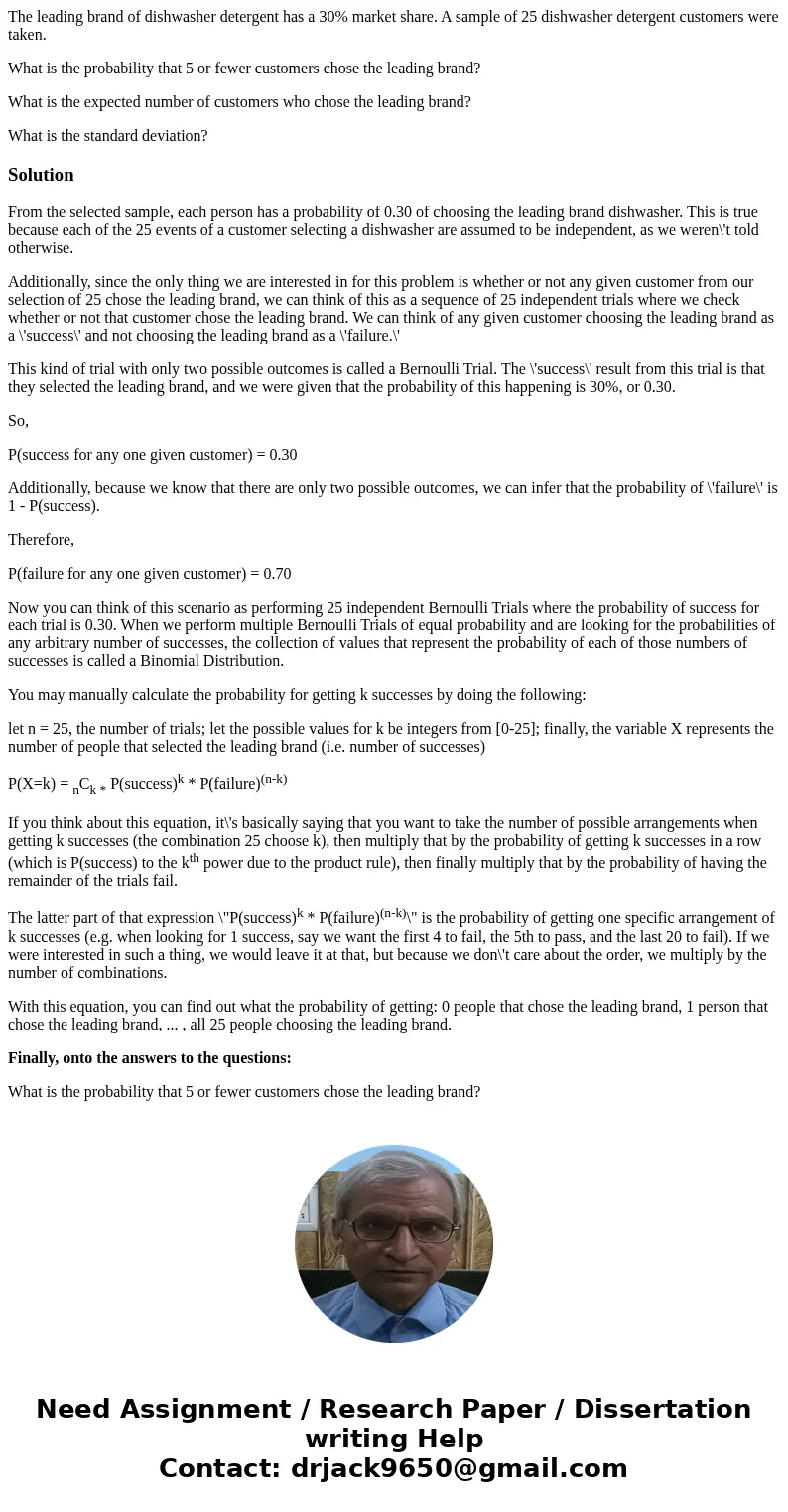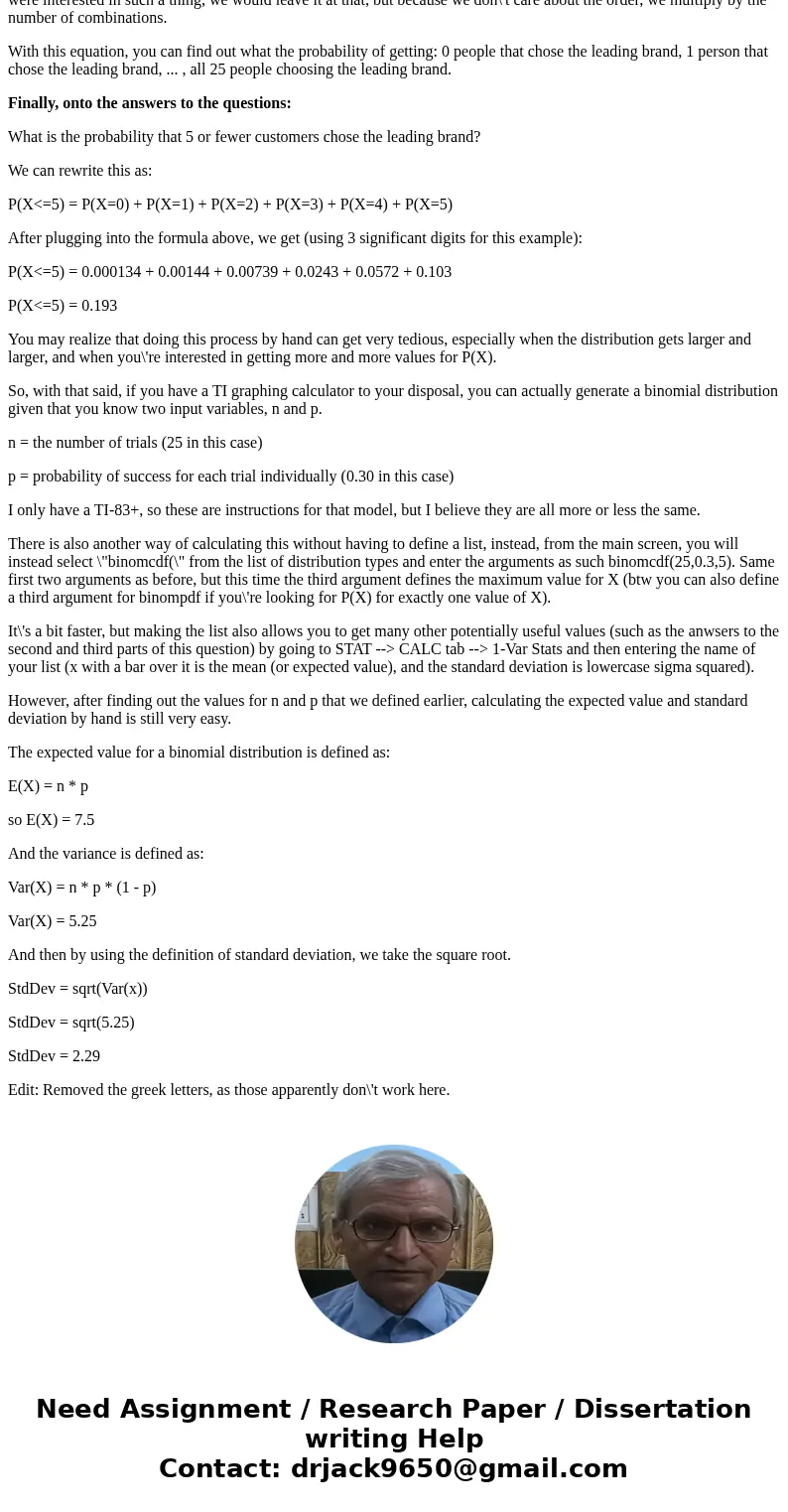The leading brand of dishwasher detergent has a 30 market sh
The leading brand of dishwasher detergent has a 30% market share. A sample of 25 dishwasher detergent customers were taken.
What is the probability that 5 or fewer customers chose the leading brand?
What is the expected number of customers who chose the leading brand?
What is the standard deviation?
Solution
From the selected sample, each person has a probability of 0.30 of choosing the leading brand dishwasher. This is true because each of the 25 events of a customer selecting a dishwasher are assumed to be independent, as we weren\'t told otherwise.
Additionally, since the only thing we are interested in for this problem is whether or not any given customer from our selection of 25 chose the leading brand, we can think of this as a sequence of 25 independent trials where we check whether or not that customer chose the leading brand. We can think of any given customer choosing the leading brand as a \'success\' and not choosing the leading brand as a \'failure.\'
This kind of trial with only two possible outcomes is called a Bernoulli Trial. The \'success\' result from this trial is that they selected the leading brand, and we were given that the probability of this happening is 30%, or 0.30.
So,
P(success for any one given customer) = 0.30
Additionally, because we know that there are only two possible outcomes, we can infer that the probability of \'failure\' is 1 - P(success).
Therefore,
P(failure for any one given customer) = 0.70
Now you can think of this scenario as performing 25 independent Bernoulli Trials where the probability of success for each trial is 0.30. When we perform multiple Bernoulli Trials of equal probability and are looking for the probabilities of any arbitrary number of successes, the collection of values that represent the probability of each of those numbers of successes is called a Binomial Distribution.
You may manually calculate the probability for getting k successes by doing the following:
let n = 25, the number of trials; let the possible values for k be integers from [0-25]; finally, the variable X represents the number of people that selected the leading brand (i.e. number of successes)
P(X=k) = nCk * P(success)k * P(failure)(n-k)
If you think about this equation, it\'s basically saying that you want to take the number of possible arrangements when getting k successes (the combination 25 choose k), then multiply that by the probability of getting k successes in a row (which is P(success) to the kth power due to the product rule), then finally multiply that by the probability of having the remainder of the trials fail.
The latter part of that expression \"P(success)k * P(failure)(n-k)\" is the probability of getting one specific arrangement of k successes (e.g. when looking for 1 success, say we want the first 4 to fail, the 5th to pass, and the last 20 to fail). If we were interested in such a thing, we would leave it at that, but because we don\'t care about the order, we multiply by the number of combinations.
With this equation, you can find out what the probability of getting: 0 people that chose the leading brand, 1 person that chose the leading brand, ... , all 25 people choosing the leading brand.
Finally, onto the answers to the questions:
What is the probability that 5 or fewer customers chose the leading brand?
We can rewrite this as:
P(X<=5) = P(X=0) + P(X=1) + P(X=2) + P(X=3) + P(X=4) + P(X=5)
After plugging into the formula above, we get (using 3 significant digits for this example):
P(X<=5) = 0.000134 + 0.00144 + 0.00739 + 0.0243 + 0.0572 + 0.103
P(X<=5) = 0.193
You may realize that doing this process by hand can get very tedious, especially when the distribution gets larger and larger, and when you\'re interested in getting more and more values for P(X).
So, with that said, if you have a TI graphing calculator to your disposal, you can actually generate a binomial distribution given that you know two input variables, n and p.
n = the number of trials (25 in this case)
p = probability of success for each trial individually (0.30 in this case)
I only have a TI-83+, so these are instructions for that model, but I believe they are all more or less the same.
There is also another way of calculating this without having to define a list, instead, from the main screen, you will instead select \"binomcdf(\" from the list of distribution types and enter the arguments as such binomcdf(25,0.3,5). Same first two arguments as before, but this time the third argument defines the maximum value for X (btw you can also define a third argument for binompdf if you\'re looking for P(X) for exactly one value of X).
It\'s a bit faster, but making the list also allows you to get many other potentially useful values (such as the anwsers to the second and third parts of this question) by going to STAT --> CALC tab --> 1-Var Stats and then entering the name of your list (x with a bar over it is the mean (or expected value), and the standard deviation is lowercase sigma squared).
However, after finding out the values for n and p that we defined earlier, calculating the expected value and standard deviation by hand is still very easy.
The expected value for a binomial distribution is defined as:
E(X) = n * p
so E(X) = 7.5
And the variance is defined as:
Var(X) = n * p * (1 - p)
Var(X) = 5.25
And then by using the definition of standard deviation, we take the square root.
StdDev = sqrt(Var(x))
StdDev = sqrt(5.25)
StdDev = 2.29
Edit: Removed the greek letters, as those apparently don\'t work here.


 Homework Sourse
Homework Sourse